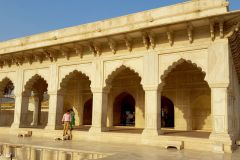Judging by the entrance visitors usually are led through, the monumental Amar Singh Gate, the Agra Fort is undoubtedly a fortress. It even has a moat around it. As soon as we get inside that impression is reduced.
The UNESCO World Heritage List includes more than a thousand properties with outstanding universal value. They are all part of the world’s cultural and natural heritage.
Official facts
- Country: India
- Date of Inscription: 1983
- Category: Cultural site
UNESCO’s World Heritage Centre’s short description of site no. 251:
Near the gardens of the Taj Mahal stands the important 16th-century Mughal monument known as the Red Fort of Agra. This powerful fortress of red sandstone encompasses, within its 2.5-km-long enclosure walls, the imperial city of the Mughal rulers. It comprises many fairy-tale palaces, such as the Jahangir Palace and the Khas Mahal, built by Shah Jahan; audience halls, such as the Diwan-i-Khas; and two very beautiful mosques.
My visit
The palaces, courtyards and large lawns add to the pleasure of walking around the area within the fortress walls. Some parts are however still used by the military and off limits for normal people. The Taj Mahal is visible in the distance, and it is said that the ruler who built it, Shah Jahan, was imprisoned by one of his sons and died here in one of the palaces of Agra Fort with a view to the famous mausoleum over his beloved favourite wife. He was later buried there himself.
Browse to the PREVIOUS or NEXT post in this series.



































